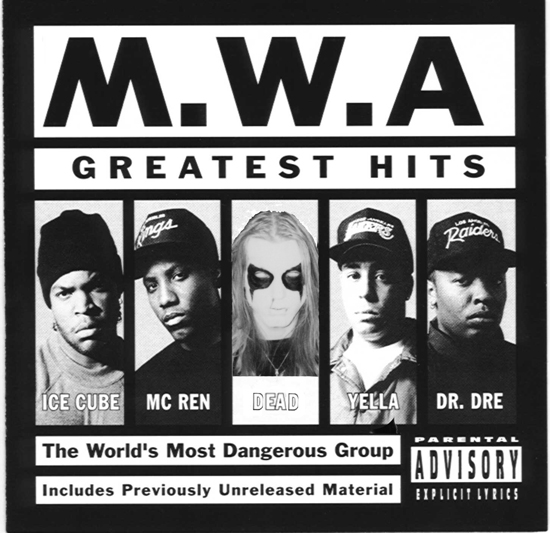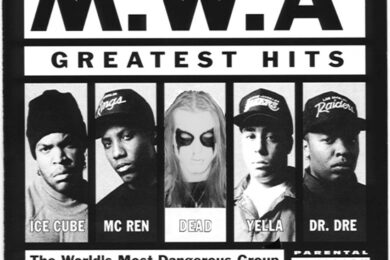Recently The Quietus travelled to Oslo to work at the By:Larm music conference and were given a handy insight into exactly how much black metal has changed in Norway over the last 20-years. On the Saturday morning I went on the first ever Black Metal Coach Tour of Oslo as I was covering it for The Word magazine and Totally Dublin. Our tour guide, Anders Odden of Satyricon and Cadaver was the ideal person for the job; funny, irreverent and knowledgeable. We took a ride up to Holmenkollen where one of the 50 churches that were set ablaze in black metal arson attacks in the early 1990s had been rebuilt next to a symbol of national pride, Oslo’s ski jump. Then we took in Helvete Records (now a very nice Vietnamese run coffee bar) and finally, the still thriving Noseblod extreme metal record store.
After spending three hours on a coach listening to Mayhem, Burzum and Darkthrone we travelled round various city centre venues watching bands. First up were Quietus favourites Årabrot who had a tangential relationship to the genre through the parched, necrotic vocals of Kjetil Nernes but who, really, have more in common with Jesus Lizard and Melvins than they do with Emperor. Then we saw Svart Greiner, an electronica artist who was one step further removed from BM, connected to the scene via the finest of ambient strands. Next up was the far more familiar but no less exciting 1349, who are firmly in the if-it-ain’t-broke-don’t-fix-it camp. Ulver were the last band of the night. A time served BM unit featuring Daniel O’Sullivan who have moved further and further away from the traditional sound, incorporating trip hop, electronica, classic rock and musique concrete into their sound. While Ulver often make an admirable and luxurious sound, they are similar to Massive Attack and UNKLE in that they also produce slightly bloodless and over polished music.
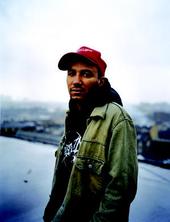
We had time to kill before the 1349 gig so we went to a nearby dubstep bar and met up with our friend Tony F Wilson, aka DJ Spykidelic and member of the Oslo avant collective Necessary. While we were catching up over a few drinks we noticed that also present in the small hipster bar were all of Ulver, Necrobutcher from Mayhem and Svart Greiner all nodding along to ‘Tarantula’ by Zomby. This prompted Tony to tell us his theory about how he thought there were big parallels between N.W.A. and Mayhem. On returning to London, I started thinking that there was something in this and ended up having this following email chat with him.
We were talking about black metal in that bar in Oslo which was playing dubstep and then all of Ulver and Necrobutcher came in for a pint, it triggered off a really interesting conversation about your theory on why NWA and Mayhem are similar. Now, you’re far from the only black guy in the world who listens to black metal but I’m guessing you’re in a minority as a black hip hop fan who lives in Oslo taking an interest in BM as well. When did you first hear black metal and what were your first experiences of it like after emigrating to Norway and going to gigs?
Tony Wilson: I was kind of aware of Norwegian metal in 1991 with the murders, church burnings and what-not but didn’t take too much interest in it. It was later in 1997 through being a fan of Harmony Korine’s early films that I really started to take notice (he featured Mayhem and Burzum on the Gummo soundtrack as well as clips of them in the movie itself). Around the same time, my friend Nathan Bennett (formerly of the band Capricorns) started going to Black Metal shows with Duncan John Dinsdale who had just set up the label Prosthetic and who I knew who from working at Selectadisc . Plus Mads Bjerke, a recording engineer I was working with a lot was from Bergen and talked a lot about going to school with Varg Vikernes, so I was always very aware of black metal although I wasn’t checking it out so much. I think I was initially more in love with the idea of it than the music itself at the time. It was the realest music in the era of “keeping it real”.
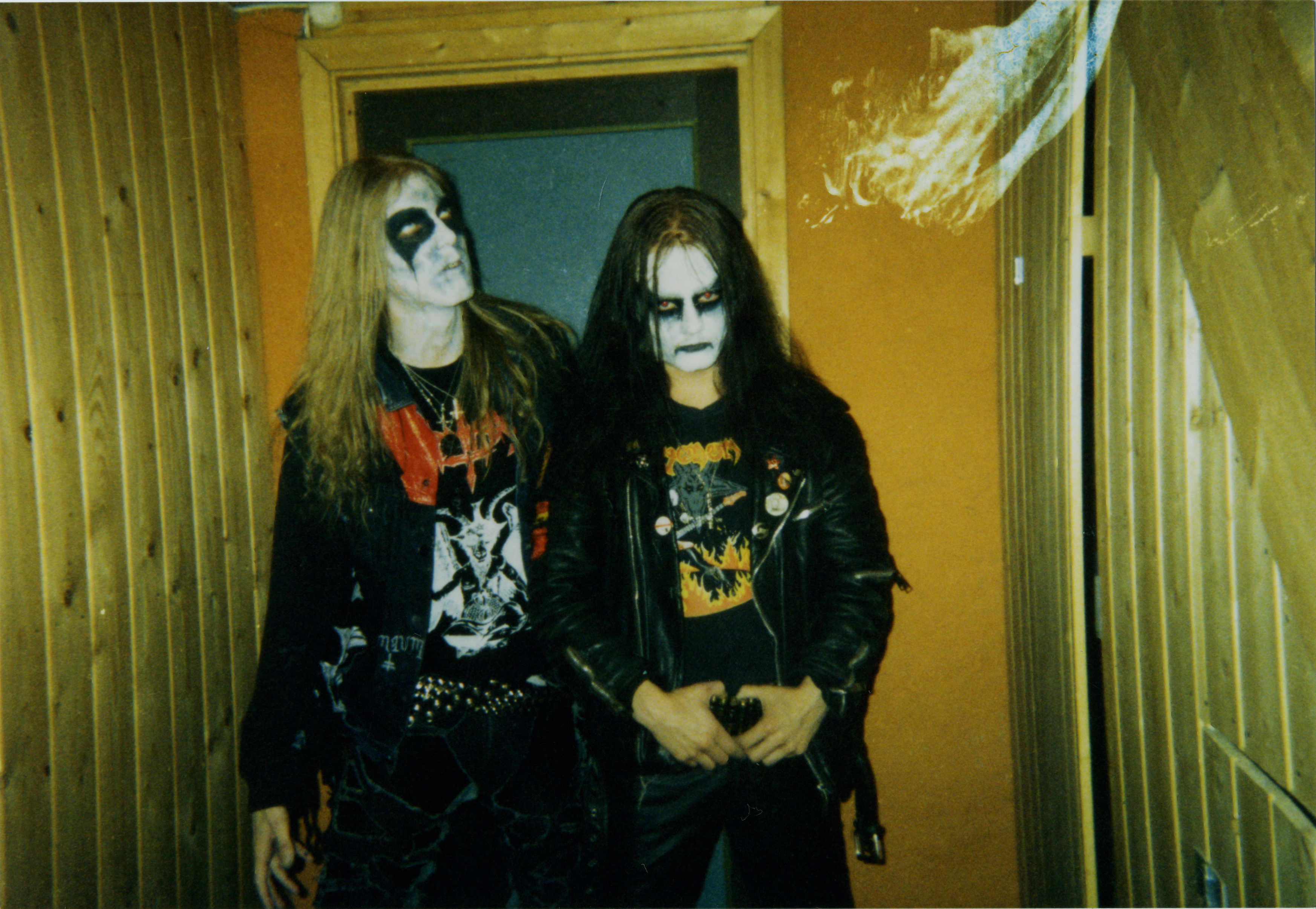
Dead and Euronymous of Mayhem
Tony Wilson: I’m by no means an expert on black metal but from my skewed perspective as a Jamaican-British-Norwegian of 5-years, I’d say it was born of the same economical frustration and under representation of the underclass that gave way to hip hop in the 80s (I don’t say punk as I think that had as much to do with fashion as anything else). Before Grandmaster Flash’s ‘The Message’, Def Jam and Spike Lee, black Americans felt they had to adhere to an image of wealth and prestige not just in the R&B of people like Alexander O’Neal but also in the early Disco Rap of Sugarhill and Enjoy Records. The hardness of Public Enemy, Schoolly D and BDP was a direct reaction to this.
I see a lot of parallels between the emergence of NWA and Mayhem. I’m sure Varg Vikernes would disagree but there are definite similarities between the way that in the early 80s America has its first black middle class (epitomized by the Cosby Show) and Norway’s nouveau-riche, that I believe, sprang-up around the same time. Remember, Norway was essentially a nation of farmers for untold centuries before they became oil rich in the 60s. Norway had Christianity forced upon it in the same way as African slaves did, so it’s no wonder that both blues and black metal are rich in Satanic imagery. Viewed in this context, you could also argue that Slayer’s Reign In Blood and South Of Heaven could not have been made for any other label other than Def Jam.
In particular I thought Norwegian black metal was like West Coast hip hop; people forget now all the hysteria after the release of Doggystyle, its artwork which basically depicted rape and Snoop’s alleged involvement in the slaying of a rival gang member. It created enough panic for the Daily Star to feature him on their front page with the legend Keep This Evil Bastard Out! I think Mayhem and NWA have similarities in the way that they both redefined their respective genres and made them synonymous with the cities they hailed from. NWA like Mayhem have their fair share of tragedy (Dead/Euronymous Vs Eazy E) and estranged members (Count Grishnackh/Ice Cube). I personally don’t think it’s a stretch to compare Ice Cube’s solo records AmeriKKKa’s Most Wanted and The Predator to Burzum classics like Aske and Filosofem . Moreover Cube like Grishnackh was also accused of racism (against Koreans) and antisemitism. Again, it’s hard now for people to fathom just how revolutionary and radical NWA and Cube were but I guess black metal is now becoming the same kind of cash cow as gangsta rap but likewise will always have true underground artists.
The first time I went to a metal gig in Oslo was when my buddy, genius artist and Dausteg partner Are Mokkelbost. He took me to see Enslaved just after I moved here in 2006. When I walked in it I felt like Wesley Snipes in that first scene from Blade in the nightclub, but to be honest, no one really paid me any mind and I felt really at ease and had a great time. I had more trouble when in my dumber days I’d DJ at Indie nights in Camden and constantly get asked if I had drugs or where I was really from. Here, I have far more friends from the metal/noise side of things, simply because they are the most open minded, knowledgeable and experimental when it comes to music and art. The dance music/club people are the ignorant genre Nazis here.

Helvete basement by Dan Dennison
Based on what you’ve experience about Norwegian culture, what do you think it is about true Norwegian black metal that made it blow up where it did (as opposed to say Iceland or Finland)?
TW: There are certain parallels in the way that in the 80s black Americans were purported to have a middle class and wealth for the first time and similarly in Norway another class, basically the noveau riche, started to become more visible. In both cultures up until that point, it was frowned upon to flaunt wealth because there wasn’t ever much of it. From then onwards, both cultures became obsessed with it. So as early hip hop was created by the impoverished with the limited tools at their disposal as a means to be heard, so I think it was maybe the same with Norwegian black metal.
Paradoxically, black metal is now one of Norway’s biggest cultural exports, but the psychological effects of the country’s rapid financial expansion on young people particularly men, who don’t adhere to the required social model, is much the same. There is massive pressure not only to be financially succesful but also to be-in-shape and look good because of Norway’s global reputation as having a good looking and healthy population. I think Norwegian black metal may possibly also partly be a manifestation of that anger and frustration. There are many great things about Norway, such as equality for women (it’s now legally required that all boardrooms be made up of at least 40% women), but you don’t hear nearly as much about the alarming rate of heroin use, mental illness and suicide rate in this small nation. I think without a shadow of doubt that these societal pressures are a contributing factor.
Can you explain what dausteg is – from the little I know about it, it sounds like your theory made into a perverse sonic reality.
TW: Dausteg is a DJ partnership I have with the aforementioned Norwegian artist and musician Are Mokkelbost. I met Are through a mutual acquaintance with Andrew from Aurora Borealis Records. We have very similar tastes in music but I have more kinship with hip hop/UK club music and he with metal and hardcore. Our friendship was noted by the best booker in Oslo, namely Ingeborg Aarsond at the tragically now defunct Spasibar, and she then asked us if we’d like to DJ together in December 2006. We naturally obliged and the resulting event was basically us playing records we liked to each other at the crowds expense. We had to think of a name quickly and I came up with deathstep as a sort of joke, which we later changed to the Norwegian rendering dausteg. The name has become a bit of a bugbear to be honest because people naturally zone in on the metal and dubstep aspect which isn’t the whole picture by far.
Our biggest event was in 2009 as part of the Ultima music festival where we given a huge church in Oslo (St. Jakobskirken) and the choice of three acts to play live. Are chose Mick Barr and a local grime-y hip hop crew called Tri-Function Million. I picked Mount Kimbie who brought James Blake along with them. So I’m now more infamous for bringing Blake to Norway very early on than for mixing Lil Wayne’s ‘A Milli’ vocal over the top of Burzum’s ‘Jesus’ Tod’. Regardless, that event was so amazing both musically and visually that we only now want to play special venues. The last one we did was in 2010 as part of an art installation by the Norwegian artist Børre Sæthre at a gallery in Harstad, which lies 250 kilometres north of the Arctic Circle. For that we based our set around Ennio Morricone’s score for The Thing and other horror and sci-fi soundtracks. We’re much more interested in that kind of thing for Dausteg and not really interested in playing regular club nights.
Dausteg – 10.09.09 St Jakobskirken, Oslo from Tony F Wilson on Vimeo.
Are there any other similarities between N.W.A./gangsta rap and Mayhem/TNBM? Dress codes (there’s perhaps something in the comparison of gangsta rap’s prison uniform and BM’s undead biker look), or codes of conduct?
TW: I think sonically the use of minor chords and orchestral synthesizer presets in West Coast hip hop, Three Six Mafia, early industrial and Grime are sometimes quite similar as in some Black
Metal. That was a major influence for what we did with Dausteg. Attitude wise, I think the West Coast’s ideological war with the East Coast has parallels with Mayhem and the members of the Black Circle being so opposed to US and English bands playing in Oslo, to the point of threatening to blow up a Slayer gig. I think both scenes have a dress code to some extent, as you say, the West Coast with the prison uniforms and TNBM with the face paint. Varg Vikernes/Count Grishnackh last year bemoaned Oslo black metal bands for acting like gays and blacks and in his more overtly Nazi days, rejected Black Metal for its links to the Blues as it was black music, so even he agrees that there are crossovers between the two cultures if you look for them.
Do you think this is something that drew the photographer Peter Beste to concentrate his career on documenting TNBM and Houston crunk?
TW: Yes I do. Pete had his first exhibition in Oslo during the same week as Dausteg in the big church and we were asked to do a talk together at the exhibiting gallery. I’ve always loved his work and would even go as far as to say I was inspired by it. I love the fact that he also documented the early grime scene in East London and likewise could see the parallels with that scene and black metal and gangsta rap. He’s a don.
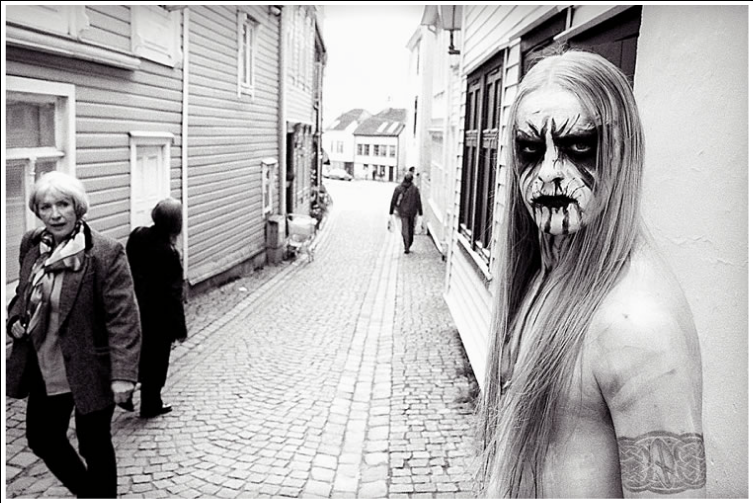
Kvitrafn of Wardruna by Peter Beste
I talked to Anders Odden recently about the burnings and murders and he said he was still deeply upset after all this time about the amount of harm that all the crime did to the actual music. He claims it stopped people from really accepting BM as an avant garde art form. Obviously there’s a case to be made for this. How much do you see BM as separate from heavy metal and an avant garde art form?
TW: It’s kind of like saying that graffiti would’ve have been accepted as an “art form” if it hadn’t been for annoying rappers and DJs – the theatrics are part and parcel of the metal culture. They always have been, long before folks began burning churches and killing each other in Norway. There’s enough going on within metal to cater to those who just want to hear avant-garde stuff – James Plotkin, Stephen O’Malley and Runnhild Gammelsæter for example. If that doesn’t do it for them then they should stop being so close minded and listen to some real heavy avant-garde music like Om by Coltrane. Also, the most infamous black metal musician also came up with its greatest avant-garde art record – Burzum’s Filosofem. When I first heard it, to me it had more in common with Blue Bell Knoll by The Cocteau Twins and early Aphex Twin than metal. Most of the black metal records I like remind me of Dead Can Dance or something. I know a lot of the black metal musicians were into that 4AD stuff as well as techno. I think black metal is in a better position for being taken seriously as an art form because of people like Stephen O’Malley, labels like Aurora Borealis and visual artists like Banks Violette than from what any particular Black Metal band is doing.
Just to clarify, I think he meant it put the development of BM back by years. I don’t think he was claiming that it has never been avant garde. I think he meant that it was avant garde from the beginning, hence the involvement of Conrad Schnitzler of Cluster and Tangerine Dream on the Mayhem track ‘Sylvester Anfang’. I think even if you listen to a modern band like 1349, behind all the panstick there’s still something totally berserk about the guitars. Also I think with bands such as Abruptum and De Magia Veretum you’re listening to music which is at once ‘true’ black metal but also like some of the most complex jazz I’ve ever heard.
TW: Yeah sure, but I hate when already successful musicians start moaning about how it was so much better in their day. It’s like that GZA gig [Liquid Swords at Koko] in London where he spent most of the gig dissing Souljah Boy. To me, when you moan about the state of current music it just means you’re not looking hard enough for the good shit. I mean I don’t really listen to that much black metal and I’m a Jamaican who was born in Croydon, yet without even trying I’ve become aware of Menace Ruine and Liturgy, two amazing contemporary experimental black metal bands, so it’s definitely out there.
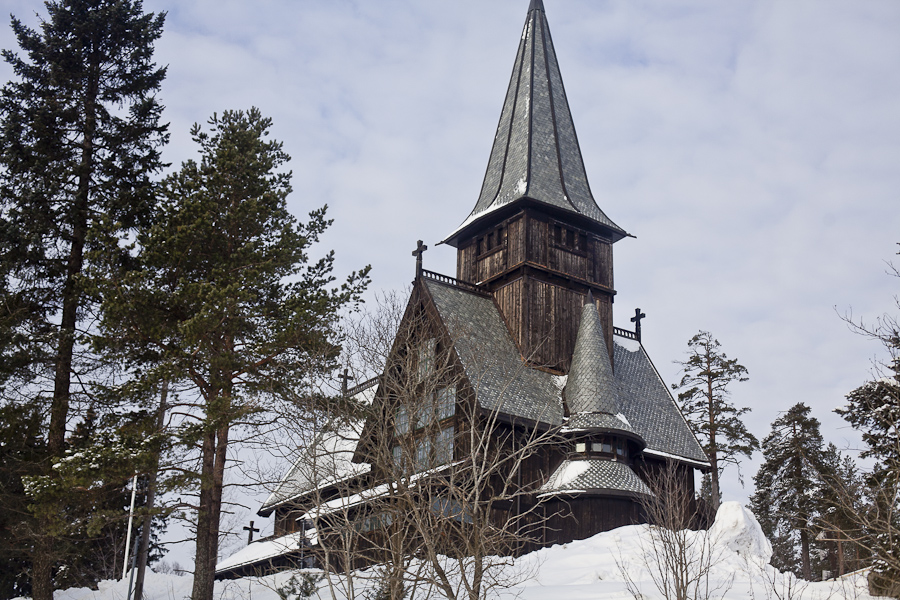
Holmenkollen Chapel by Dan Dennison
Yeah, I love those two bands. I think the most of the interesting stuff is definitely post-black metal, like Liturgy, Gnaw Their Tongues, Celeste, Murmurres etc. While I love listening to stuff that has naught but a hint of BM aesthetic – whether that’s Årabrot or Svarte Greiner – is there any downside to BM being co-opted by younger, ‘hipper’ dudes? Should the old guys in corpse paint just accept that they’ve had their time ‘in the sun’? I’d like to state for the record, I’d much sooner listen to the so-called hipster BM of Liturgy than the old schoolers who’ve moved on such as Ulver or Dimmu Borgir. But then I do listen to a lot of straight up brutal BM as well.
TW: I think the old guys in corpse pain have actually accepted that they’ve had their time and are just happy that there’s still an audience for what they do, so have no problem whatsoever with the young hipsters. I mean, you saw Necrobutcher at Illegal Burger, he looked happy as Larry. He actually went up and chatted to my buddy Stian who was playing shit like Zomby and Kassem Mosee that night, so I don’t think he has a problem with hipsters at all. I don’t think there’s ever a downside to younger bands grabbing the baton or rather in this case, the axe. Normally the people who moan to me about my taste in what they term “fake metal” like L’Acephale and Wolves in the Throne Room, usually have a piss-poor “drone metal” project, work in media or are just plain insecure.
Watch the Quietus for a feature on Necessary later in the year

